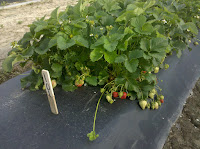There has been a lot of news lately about the fast, furious, and fantastic North Carolina strawberry crop this spring. I have posted about the almost overwhelming harvest at the Central Crops Research Station, which looks to be slowing a bit in the next few weeks. In fact, most of the heavy strawberry picking in NC should be tailing off by the end of May. This is good for my research program, since we're moving on to blueberries, blackberries, and tobacco this time of year, but is not necessarily music to the ears of growers or consumers. We are not seeing lower yields in 2010, just a more concentrated crop.
This short season has some direct pest management implications that growers should be aware of. First for our key arthropod pest of strawberries, twospotted spider mites. I have only gotten phone calls from one grower with spider mite issues this spring! Either you are all comfortable with your management programs, or this was a mild mite year. My money is on the later, as we did not have a single spider mite in our research plots at Central Crops until mid April, and even then, we had to manually infest to generate the number that were needed for our threshold and efficacy trials. The low spider mite numbers are due to several factors: Cold winter weather decreased mite populations and produced very hardy, healthy plants. Healthy plants do not harbor as high mite populations as stressed plants, and they can better tolerate the populations they do have. The fast fruiting season also reduced the importance of TSSM. Fruiting strawberry plants can tolerate higher numbers of mites than young plants. Finally, the rapid harvest season has likely rendered the use of miticides unnecessary. Even the most effective conventional miticides take 2-3 week for full efficacy because they act on all mite life stages. When it appears our season will be winding down in that same amount of time, a miticide treatment is probably not advised. Of course, there are always exceptions to this rule, and I encourage growers and agents to contact me with questions.
Next, thrips: 2010 has been, as expected, a late thrips year with relatively low populations. Thrips treatments are likely not justified. I address other thrips related issues in posts here and here.
Lygus bugs are of the same ilk as thrips this season. We will be out of strawberry harvest before they are likely to be an issue.
Finally, sap beetles. These late season pests may rear their ugly heads in 2010 not because we have a long field season which will stretch into to heat of summer but instead because the sheer volume of fruit in a short period of time may result in less thorough picking by both employees and customers. Sanitation is crucial for sap beetle control and is often sufficient by itself. Chemical controls should be our last option, but they are available.
Just some of the news stories from throughout the state:
WBTV Charlotte at Hall Berry Farm
WRAL's Go Ask Mom blog on organic strawberries near the triangle
WRAL and Dr. Barclay Poling at our research plots at the Central Crops Research Station, Clayton, NC
WECT's Strawberry Festival Coverage
WWAY on Columbus County strawberries
Sampson Independent on the large crop
In the Field on strawberries in NCDA's Food to School Program

No comments:
Post a Comment